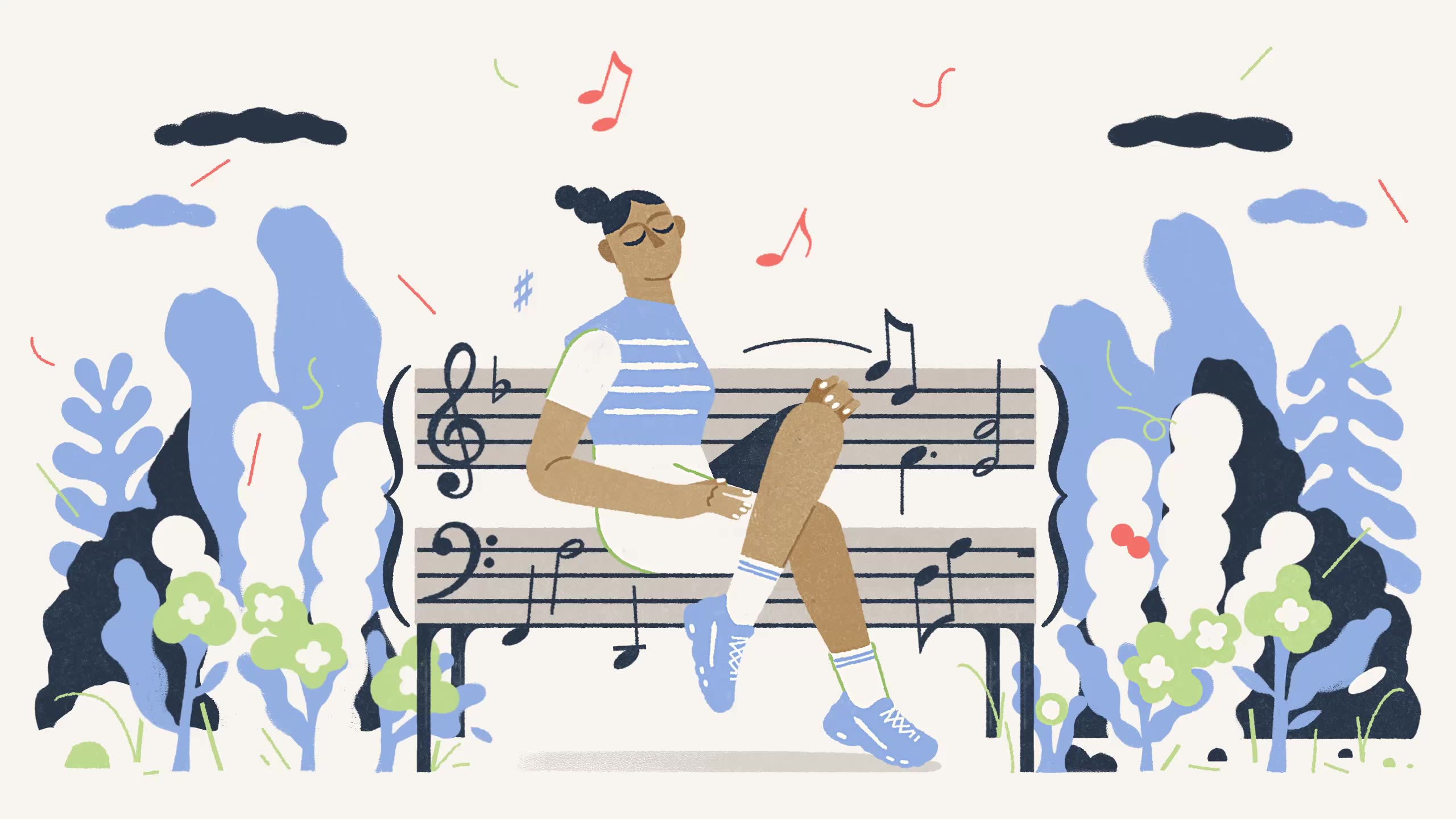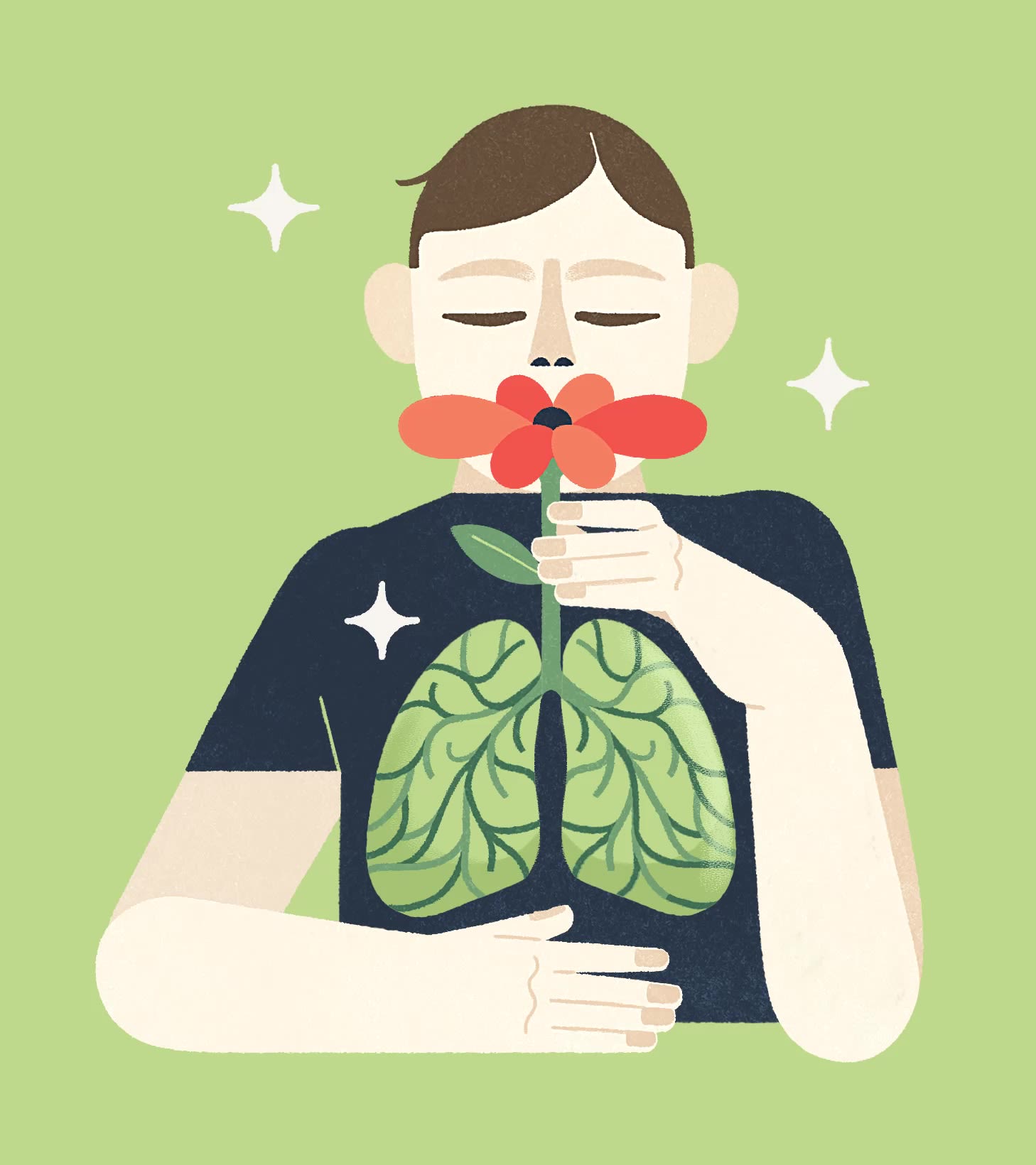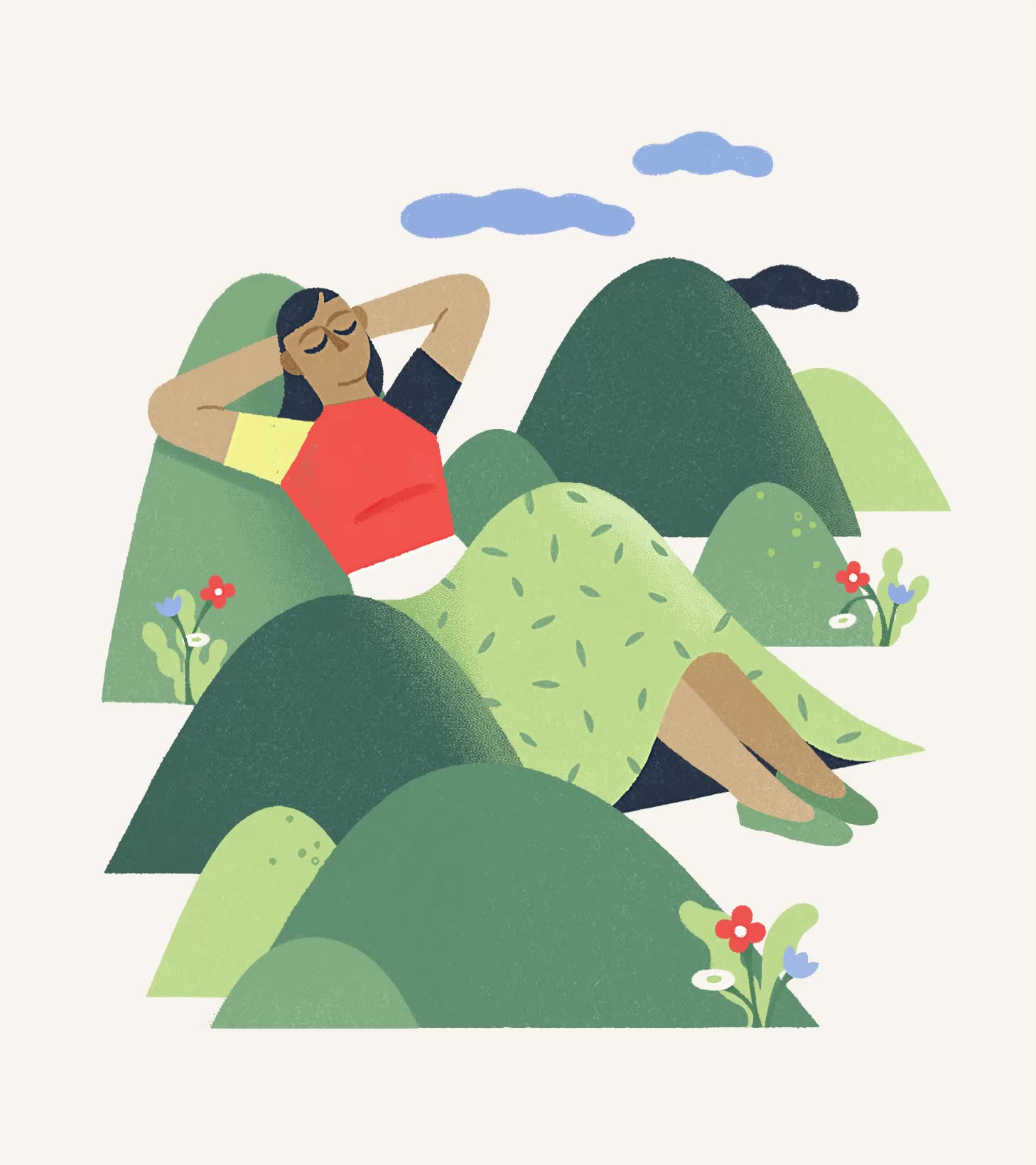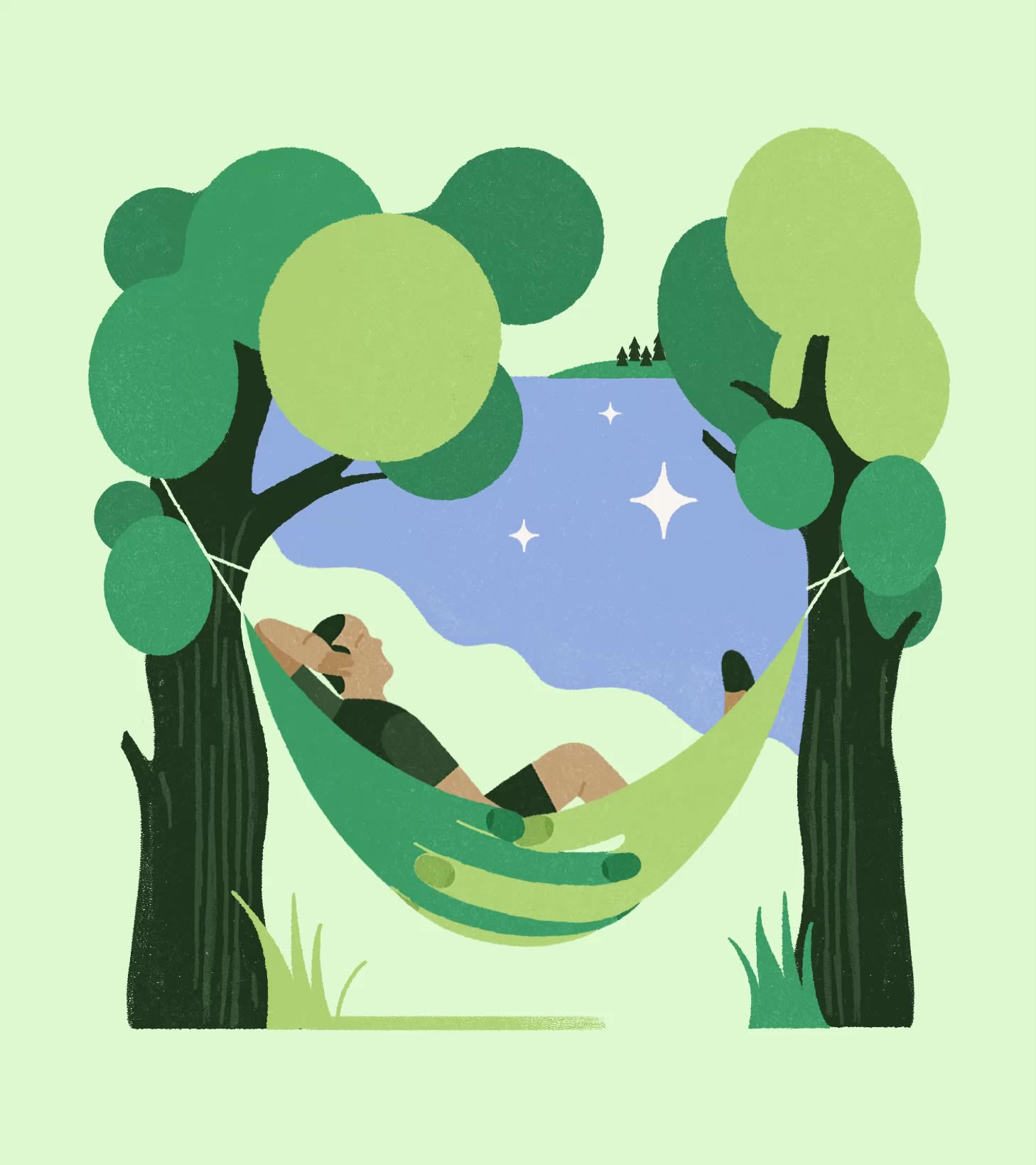
The Nature
of Well-Being
// By Eils Lotozo
// Illustrations by Gracia Lam
The Nature
of Well-Being
// By Eils Lotozo
// Illustrations by Gracia Lam
Pioneering conservationist, inveterate wilderness hiker, and Sierra Club founder John Muir had a serious thing for nature.
“Everybody,” he once wrote, “needs beauty as well as bread, places to play in and pray in where nature may heal and cheer and give strength to the body and soul alike.”
It turns out that Muir—known as the father of our national park system—was more right than we could have imagined.
Countless studies over the past two decades have increasingly revealed that nature has remarkable powers to improve our lives in myriad ways.
The research has shown that experiences of nature—as simple as walking in the woods or gazing at a lovely natural vista—can help alleviate depression, improve cognition, aid recovery from illness, and change a negative body image. Some studies have even found that a nature experience such as a simple stroll in the park can increase levels of altruism, making a person more willing to assist a stranger in need. In other words: Nature can help make us better people.
Students in a Purdue course called Beyond Mental Health: The Science of Well-Being are getting the chance to learn about some of those benefits themselves.
One of the assignments for the course: Take a walk in nature.
Instructor Louis Tay, the William C. Byham Professor of Psychological Sciences, asks his students to commit to spending time each day over four days walking outdoors in a natural setting.
“And then I ask them to record their experience and the degree to which it made them feel happy,” says Tay, whose course investigates the nature of happiness, including ways to measure and promote it and its effect on health and longevity.
The nature walk is part of the hands-on component of the class, which has students trying out various practices aimed at boosting well-being.
“I’ve taught this course for four years now, and what I hear from students is almost always positive,” Tay says. “Students report being happier after the walks as compared to their baseline when they first signed up for the class. I don’t tell them until after they do it, but research has shown going for a walk in nature increases well-being.”
According to the research, such walks can induce relaxation and help with stress reduction. And it’s not only the sight of tranquil green spaces that benefits us psychologically, Tay points out. Being outdoors has a physical effect as well. Sunlight synthesizes vitamin D in the skin, and that helps regulate the production of serotonin, a hormone that can elevate mood, focus, and calmness.
Tay says that experiences in nature can inspire feelings of awe and wonder, increasing feelings of well-being. They have also been shown to restore attention. There’s a concept called Attention Restoration Theory, which posits that nature restores our concentration by engaging our relaxed attention as we view rustling tree limbs, drifting clouds, and flitting birds.
“That’s a great benefit because I think we’re all having challenges with our attention spans these days,” says Tay, who requires his students to leave their phones at home during their outdoor treks.
“We’re spending a dominant amount of time staring at our phones or screens, and I don’t think that’s particularly healthy. We are not evolved to do that. We are creatures who need an embodied experience.”

For Gabrielle Sjoberg (A’08), connecting people to nature has become her life’s work.
The wildlife science alumna, whose master’s degree in biology from Miami University focused on outdoor programming, has helped kids discover nature at the Indiana Dunes National Park, ran nature programs and camps at the Natural History Museum of Los Angeles County, and led youth conservation corps programs in Angoon, Alaska.
Currently, she is managing a regional youth stewardship program overseen by the Central Council of the Tlingit and Haida Indian Tribes of Alaska, splitting her time between Juneau and Angoon, which is located on an island only accessible by charter boat, seaplane, or ferry.
“I’m working with kids who, even though they’ve grown up in these remote wilderness areas, have not necessarily done much exploring in the bays and rivers,” says Sjoberg.
The rural and Indigenous youths in the program work on projects such as clearing trails and fallen trees with program partners, including the United States Forest Service, and also help with the traditional seasonal harvesting, preservation, and distribution of foodstuffs that are crucial for locals: salmon, clams, moose, deer, herring eggs, blueberries, and beach asparagus.
“It feels like such a privilege to be a witness to them connecting to their homeland, to this land their families have been part of for generations,” says Sjoberg, who sees nature as a force for connection as much as something we all need to connect to—and not only for its health-giving effects.
“Nature draws out powerful connections—connections to self, connections to the Earth and all that is beyond, and connections to each other.”
Sjoberg has felt some of that during her own experiences in the wild. On a camping trip in Alaska, she recalls glimpsing a pod of orcas moving alongshore at twilight and hearing their breathing. On a trip to Minnesota’s Boundary Waters, she remembers going out in a canoe at night.
“The water was incredibly flat and there was a new moon and so many stars,” she says. “They were perfectly reflected in the water, so it looked like we were floating in stars. You get back home, and you have that inside of you—it becomes a part of the fiber of your being. Those kinds of experiences give you perspective and appreciation. I never feel as centered as I do after a trip in nature.”
But you don’t actually need to trek to remote locales to find nature, Sjoberg observes.
“Even in a city like LA, there is so much life all around, all the time. It is bursting through this Earth. There are plants and animals that are surviving and adapting to the environment they are in. Nature isn’t only in the wilderness. It’s everywhere.”

Talk about experiencing nature, and we tend to envision something big and scenic, like trees, forests, mountains, or meadows. But Laura Kavanaugh (ChE’87, S’87, MS ME’89) has forged a deep relationship with nature on a very elemental level.
She studies dirt.
Kavanaugh is the chief science officer for Advancing Eco Agriculture, a firm that helps farmers make the transition from conventional farming—with its heavy inputs of chemical fertilizers, herbicides, and pesticides—to regenerative agriculture, which emphasizes good soil health as the basis for plant health.
Trained as an engineer, Kavanaugh started out working as a control officer on space shuttle missions, then got a PhD in genetics and took a post at an agricultural research company developing GMO plants. But after a decade of that, she had an epiphany.
“I just realized that GMO plants aren’t going to solve our problems in agriculture, and I started to study what would work for the long term,” she says. “That’s when I discovered natural systems, which is how plants interact with microbes in the soil.”
It’s a kind of barter arrangement, as Kavanaugh explains it, with plants and microbes feeding each other, and microbes modifying soil structure in a way that helps it hold water.
Nature’s ability to spark awe and wonder is something Kavanaugh knows all about. Though soil may seem like nature at its most lowly and modest, that’s not the reality, she says.
“Soil is a huge source of life. I get a tiny little sample of soil and sequence it, and there are thousands of species of microbes in there. That’s why I find DNA sequencing so fascinating. It opens our eyes to this whole universe. It’s mind-blowing. It’s just so much bigger and more powerful than we even know.”
During the pandemic, Kavanaugh, who had been laid off from her job, got the chance to work on a farm near her home in North Carolina. The owner was starting a vineyard using regenerative farming methods, including planting cover crops—grasses and legumes that feed and hold the soil in between plantings of primary crops.
“It was the best experience ever,” Kavanaugh says. “I loved being outside, and now I understand what farmers are dealing with. It’s super easy to say, ‘You should do this and you shouldn’t do that,’ but in practice, a lot of these things are challenging.”
Still, she sees a change coming.
“Conventional farming has reached a major crisis,” she says. “Soils are eroding and profits are evaporating. There’s a huge amount of education that has to take place to get farmers to transition. But I think we’re going to get the critical mass.”
When it comes to well-being, Kavanaugh places the growing of wholesome food at the forefront.
“Regenerative agriculture is the only thing I’ve seen where everything is a win-win. Food is healthier, humans are healthier, and the environment is healthier. It’s all about the relationship between plants and microbes, and that’s a relationship that nature has already figured out.”

Carol J. Michel (A’81) is well acquainted with the many health and well-being benefits that come with getting up close to nature.
Michel, who followed up her degree in horticulture with one in computer technology, spent 33 years as an IT specialist in the health-care industry but never lost her deep connection to the green world.
After taking early retirement, Michel developed a second career as a gardening writer. She has written five volumes of humorous yet helpful essays on gardening—her latest is Digging and Delighted: Living Your Best Garden Life—and she has a long-standing blog, May Dreams Gardens. Michel also cohosts a weekly podcast, The Gardenangelists, with fellow gardener and writer Dee Nash.
The self-described “evangelist for gardening” has always sought nourishment in nature—in whatever way she could find it during her nine-to-five life.
During breaks in long management meetings, Michel was known to put up YouTube videos of forests with the sounds of birds singing. During a rough wave of layoffs, she once took a fellow manager who was dreading giving employees the axe on a nature break.
“We drove to a park nearby that has a conservatory,” recalls Michel. “It’s not very big, but we walked around for about 30 minutes, and there were tropical plants all around us and orchids blooming. Afterward, she said, ‘I feel better.’ I said, ‘I knew you would.’“
At lunchtime, Michel would often stand under a small grove of trees in the parking lot to do her own mini version of “forest bathing”—the Japanese practice of mindfully connecting with a natural environment. Researchers have shown that forests are full of phytoncides—antimicrobial compounds released by trees and plants—that can benefit the immune system. The oxygen-rich air can aid brain function and help to reduce depression.
Gardening can be a cure for all kinds of psychogenic ailments, Michel says.
“I had a friend who was going through a divorce—rather than go home to an empty house, she would come to my house in the evening and weed.”
During the pandemic, Michel’s sister—a nurse working in infection prevention—would come home from grueling days at the hospital and tend to her newly created garden. “She said that’s what kept her going—getting outside in nature.”
One thing Michel firmly believes: “People are happier with their hands in the dirt.”
She’s right. In fact, ongoing research has shown that a natural antidepressant in soil called Mycobacterium vaccae can mirror the effects of drugs such as Prozac. Other studies have shown that children raised in rural areas—in proximity to farm animals and bacteria-laden soil—develop more stress-resilient immune systems and may have a reduced risk of mental illness, compared to those who grow up in cities.
“People are realizing that nature’s a lot more important than we thought it was,” Michel says.

The Nature of Teaching
In 2005, when journalist Richard Louv published his groundbreaking book Last Child in the Woods: Saving Our Children from Nature-Deficit Disorder, research on the ways natural environments can benefit humans was just getting started.
Inspired by Louv’s book, Rod N. Williams (A’96, MS A’98, PhD A’07), then a Purdue professor of wildlife sciences and an Extension wildlife specialist, began convening focus groups of local teachers to find out what they needed to be able to better educate children about nature.
The teachers said they needed training, good science-based lesson plans, and a repository of natural resource–related information they could easily access. In response, Williams created a comprehensive professional development program for teachers called the Nature of Teaching, housed in the College of Agriculture’s Extension program.
Williams recently left Purdue for Texas Tech, where he serves as vice provost for outreach and engagement, but his legacy lives on in the Nature of Teaching program, which is now codirected by Veronica (Yager) Bullock (A’17) and Jarred Brooke (A’12), who is also an Extension wildlife specialist.
The program’s three areas of focus—wildlife, food waste, and health and wellness—provide standards-based curricula along with suggestions for informal “field day” activities, all centered around getting kids outside.
One of the health and wellness units, “Benefits of Connecting with Nature,” summarizes some of the key research on the relationship between outdoor experiences and well-being and cautions:
“If the sedentary, indoor, screen-focused lifestyles of children today are not changed, there is likely to be a high cost to their health.”
Teachers can download the Nature of Teaching materials for free and teach the lessons themselves, or they can request that an Extension educator come into the classroom.
According to Bullock, who has taught many of the Nature of Teaching units as well as workshops for teachers, the lesson plans have been downloaded 400,000 times since the program’s launch. “That shows there’s a real interest in this,” she says.
And there’s a compelling argument for it too, according to a research paper cited by Louv in a recent article from The MIT Press Reader titled “The Transformative Power of Nature on Children and Society.” That paper, a systematic survey of nature-related education, concluded:
“Schools that offer a natural space for play and learning, take students on field trips to natural areas, and bring nature into the classroom reduce stress, boost cognitive functioning, and may raise standardized test scores and graduation rates.”
Says Bullock, “The term nature-deficit disorder was coined in Richard Louv’s book, but I think it’s going to be even more of an issue in the future. There’s just been an explosion of digital technology that we couldn’t have imagined. So there’s a need for this. We’re determined to keep building the program.”

A Campus Landscape to Boost Well-Being
In his book The Nature Principle: Reconnecting with Life in a Virtual Age, Louv writes, “Every day, our relationship with nature, or the lack of it, influences our lives.”
But to build that relationship and experience the restorative power of nature, we need easy access to green spaces.
At Purdue, the RecWell Outdoor Master Plan is in the process of exploring ways to increase that kind of access.
“The COVID-19 pandemic taught us the crucial importance of being outside and connecting with nature as well as the value of social interaction,” says RecWell Senior Director Mike Warren. “Through the Outdoor Master Plan, we aim to create more outdoor destinations for students that offer options to move, connect with nature, and connect with others.”
RecWell, a sprawling department that oversees sports, fitness, and wellness activities, has brought a wide range of campus stakeholders into the planning process—including engagement from more than 2,000 students, 12 focus groups, and contributions from a steering committee made up of representatives from five university departments—as well as a team of consultants.
Among the ideas for increasing green spaces for nature connections:
Todd’s Creek Improvements
A study has recommended enhancing Todd’s Creek to address erosion issues. The plan includes widening the creek and potentially creating pooling areas, providing students with opportunities to engage with natural creek environments. Also under consideration: building two “boardwalk” bridges with seating, allowing visitors to immerse themselves in nature and enjoy the sounds of the creek. Additional naturalized seating areas would also be created along the banks.
Hammock Village
Another proposal involves the creation of a hammock village near Pickett Park or in the surrounding tree lines, allowing students to check out hammocks and relax in a peaceful setting.
Pickett Park Enhancements
Suggestions for the park include an expansion of the art walk and the addition of a natural stone terraced seating area.
Warren emphasizes that all of the proposed campus amenities are part of a visionary plan that is still in process.
“These ideas can be added to or refined based on needs and donor support,” he says. “We’re in the early stages of the process and no official commitments have been made yet. Once the estimated pricing is secured, RecWell will launch a larger campaign to educate and engage campus and alumni.”

IMPACT THE CAMPUS LANDSCAPE
Make a gift to help fund the RecWell master plan today!
Read more stories from this issue of Purdue Alumnus magazine.
